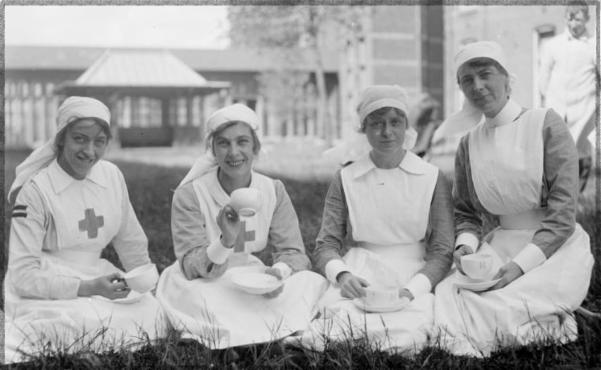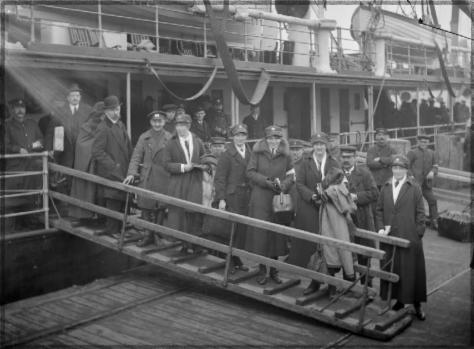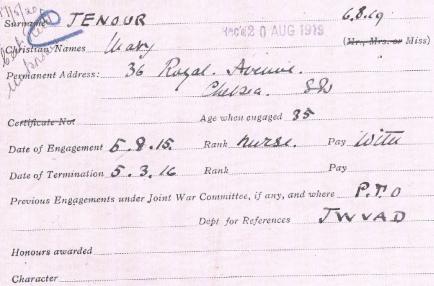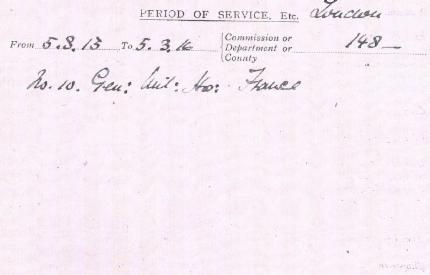THE FAIREST FORCE
3. THE VAD
*****

VADs at Chatham [Imperial War Museum Q18925]
Following R. B. Haldane's Territorial scheme of 1907 new possibilities arose of co-operation between voluntary agencies and the Army and on the 16th August 1909 the War Office issued its ‘Scheme for the Organisation of Voluntary Aid in England and Wales.' This set up both male and female Voluntary Aid Detachments to fill certain gaps in the territorial medical services with a similar scheme for Scotland following in December of that year. Detachments were organised for their local Territorial Force Association by the British Red Cross Society and members received preliminary training in first aid and nursing from the St. John's Ambulance Association.[23] After October 1914 this responsibility was transferred to the Joint War Committee [JWC] of the British Red Cross Society and St. John of Jerusalem, a wartime amalgamation of the two organizations. The scheme proved popular, particularly with women, and immediately prior to the outbreak of war there were 1,823 female detachments and 551 male detachments registered with the War Office.[24]
The women who joined Detachments were a mixture, being a wide range of ages and with different sorts of life skills. As a group they were very much defined by being middle or upper middle-class and in the main they were the daughters of local gentry, landowners, army officers, clergy, and professional men and also included a number of women with an aristocratic background. The majority were young women who had never previously had any paid employment and of those who eventually went on to wartime service more than three-quarters had either never worked outside the home or had done work which qualified them for payment of a minor nature.[25] Following the outbreak of war members of female detachments staffed VAD hospitals and auxiliary units and quickly came to be referred to by the initials of their organization. As the number of medical units both at home and broad escalated, the difficulties of keeping so many hospitals fully-staffed became increasingly difficult.
In the spring of
1915 the War Office agreed that VADs could be employed in the large military
hospitals at home to augment the trained staff and by May of that year in general
hospitals overseas as well.[26]
At the same time they also created the
post of ‘Special Military Probationer’ [SMP] or ‘War Probationer.’ These were, to all intents and purposes, VADs
directly employed by the War Office with no responsibility or affiliation to
the Joint War Committee of the British Red Cross and Order of St. John. They served under identical terms and
conditions to other VADs and received an initial three month period of nursing
experience in a large training hospital before being posted to military
hospitals throughout the United Kingdom. The first eight Special Military Probationers
to serve in France arrived in Boulogne on the 7th August 1915.[27]

VADs disembark at Boulogne [Imperial War Museum Q7974]
In
an effort to find enough suitable VADs to supply British hospitals in
France quickly, there were some who were deemed experienced enough to be
sent directly, without first undergoing a period of work in a home
military hospital. Mary Jenour was a mature woman and an experienced
psychiatric nurse when she first joined as a St. John VAD in June 1915, a
member of London/148 detachment. On August 5th 1915 she embarked for
France and No.10 General Hospital at Rouen where she worked for the
following seven months before returning to the UK to pursue other
employment. She acts as an example that not all VADs followed the same
course and there were always exceptions to the rules.


Mary Jenour's service card shows she had no prior VAD experience before being sent to France under the auspices of the War Office [Courtesy of Joan Jenour and British Red Cross Society Archives]
Contrary to popular belief, members of Voluntary Aid Detachments working in France never worked in forward medical units such as Casualty Clearing Stations and Field Ambulances and were restricted to General Hospitals in the base towns, most of which were situated close to the coast.[28] In July 1917 as the shortage of trained nurses worsened, a few of the most experienced VADs were transferred to a number of suitable Stationary Hospitals:
Sent orders to Havre, Etaples and Rouen for senior members to proceed to 6 and 12 Stationary Hospitals, it being necessary that these hospitals should now have a portion of V.A.D. Members owing to the shortage of trained nurses.[29]
From May 1916, VADs employed in home hospitals under the direction of the Joint War Committee were allowed to wear a white horizontal stripe on each sleeve of their work dress, four inches below the shoulder, to indicate that they had served continuously for a period of at least thirteen months.[30] The white stripe acknowledged length of service but was not a recommendation as to capability or competence. At that time the issue of stripes was unfamiliar to the War Office and when VADs started reporting for duty in France with such a mark of distinction there was some dissatisfaction that VADs working in military hospitals there were unrecognised in this respect. The Director of Medical Services in France, Sir Arthur Sloggett, was keen to promote the contribution of VADs and to develop a method by which skills gained during their service could be recognised, leading eventually to some form of promotion. Over the next year War Office initiatives led to a scheme for the issue of scarlet efficiency stripes to VADs employed solely in military hospitals under War Office control, both in the United Kingdom and abroad. A War Office letter of 6th May 1917 set out the terms of the award which came into effect from that date:
G.Os. C-in-C. are informed that it has been decided to award some mark of distinction to nursing members of Voluntary Aid detachments working in military hospital, in place of the white service bar at present worn.
2. This distinction will be known as 'The Efficiency Stripe,' and will be given to nursing members after thirteen months' consecutive service in military hospitals nurse by Queen Alexandra's Imperial Military Nursing Service and the Territorial Force Nursing Service only. The fact that a member has completed thirteen months' service will not, however, necessarily entitle her to the distinction, unless she is considered, by the Matron and C.O. under whom she is serving, to be in every way suitable.
3. The efficiency stripe will be one scarlet bar worn on the right arm, below the shoulder and on the indoor uniform only.
4. On completion of a second year's service in these hospitals, a second scarlet stripe may be granted on the same conditions, but under no circumstances will more than two stripes be worn.
5. The certificate which entitles a member to these distinctions will be signed in duplicate by the Matron and C.O.; one copy will be given to the member and the other retained in the hospital until the member resigns, when it will be forwarded to Devonshire House.
6. Members who are in possession of these stripes will, as far as possible, be given the duties of junior nurses, but they must be prepared at any time to continue the ordinary duties of probationers in military hospitals.
7. Those who now possess the white service bar will only receive the scarlet efficiency stripe in its place provided they fulfil the above-named conditions.
8. Special war probationers employed in these hospitals will also be eligible for the efficiency stripe.[31]
This meant that VADs who qualified under the new regulation had seen service in military hospitals under War Office control since November 1915 in order to gain their first efficiency stripe and if their service continued unbroken they received their second stripe twelve months after the first. This detail can be useful in the dating of photographs as some certainty can be expressed about them being taken ‘after May 1917’ where VADs with one scarlet stripe are visible or ‘after May 1918’ where two are worn. In March 1918 it was decided to create a new grade, the ‘VAD Assistant Nurse,’ as set out in Army Council Instructions:
1. It has been decided that special military probationers and nursing members of Voluntary Aid Detachments who have completed two years' continuous service in Military, Territorial, or War Hospitals, shall be eligible for the grade of V.A.D. Assistant Nurse.
2. It should be clearly understood that promotion of special military probationers and V.A.D. nursing members to this grade is to be recommended for efficiency only, and not for length of service, and candidates selected must have been already awarded the red efficiency stripe authorized by W.O. letters 83/7924(A.M.D.4) of 6th may, 1917, and 83/9885(A.M.D.4) of 22nd December, 1917, copies of which are printed below.
3. Recommendations should be made by the matron of the hospital in which the candidates are serving, on a special form to be circulated. These will be counter-signed by the C.O., and, in the case of the T.F. Nursing Service, by the Principal Matron also, and forwarded for final approval through the official channels to the Secretary, War Office.
4. Special military probationers and V.A.D. nursing members appointed to the grade of V.A.D. assistant nurse will wear the letters A.N. in metal on the right strap of their aprons in indoor uniform, and on the shoulder straps of their outdoor uniform coats.
5. Promotion under this A.C.I. will not carry any increase of pay, which will remain as for V.A.D. members.[32]
It must be
mentioned here that there was also another type of ‘Assistant Nurse.’ These were women who had undertaken some type
of formal nurse training but not of a length or type that satisfied the War
Office conditions for their employment as qualified members of QAIMNS or the
TFNS. In the main they were Registered Fever Nurses, Mental Nurses, Children’s
Nurses and Midwives who had completed a two year training in their specialty
but had not the required experience in general nursing. Numbers were small, and their pay scale fell
between that of a fully-trained nurse, and that of a VAD, set at £30 per
annum with the same allowances as trained nurse members.

General Service VADs, No.10 General Hospital, Rouen [IWM Q8104]
In 1915 a
separate VAD General Service Section was formed to take over jobs previously
done by men in military hospitals in order to release them for more pressing
service. Initially the women selected
worked in UK hospitals as clerks, typists, drivers, dispensers, telephonists,
cooks, storekeepers, waitresses, house-members, laundresses and ward-maids. From October 1917 they were also employed in
British military hospitals in France and the following year in Salonika and
Italy.
After the Armistice a small number of General Service VADs moved to Germany with hospitals set up to serve the needs of the British Army of the Rhine [BAOR].[33] During the course of the war more than 90,000 women served as VADs in some capacity; 10,000 worked in hospitals under the direction of the War Office and of those, 8,000 served overseas, in France, Malta, Serbia, Salonika, Egypt and Mesopotamia.[34] On the last day of November 1918 there were 1,715 nursing VADs and 943 General Service VADs working in General and Stationary Hospitals in France and by the end of June 1919 there remained a total of 860, including 120 working with units attached to the British Army of the Rhine.[35]
The British Red Cross Society are in the process of putting online copies of service records they hold for volunteers of all types who served during World War One, including VADs. Currently only records for surnames starting with the letters A and B are available, but this is an impressive project which will give immense help to all those searching for anyone who worked for the BRCS or Order of St. John during the conflict. Records are free to search and can be found here:FIRST WORLD WAR VOLUNTEERS
[23] Anne Summers, Angels and Citizens, Routledge and Kegan Paul 1988, page 247
[24] Reports on Voluntary Aid rendered to the Sick and Wounded at Home and Abroad and to British Prisoners of War, 1914-1919, (Joint War Committee of the BRCS and St. John of Jerusalem, HMSO 1921), p.190
[25] Imperial War Museum Women’s Work Collection, BRCS 10/5/4
[26] The National Archives WO293/2, Army Council Instruction 101 of March 1915
[27] War Diary of Matron-in-Chief, The National Archives, WO95/3988
[28] This situation changed in late 1919, after which date General Service VADs were used to replace men in the few Casualty Clearing Stations kept open to serve the needs of the British Army in peacetime. The National Archives, WO95/3991
[29] War Diary of the Matron-in-Chief, The National Archives, WO95/3989, 17 July 1917
[30] Imperial War Museum, Women’s Work Collection, BRC10, 4/10 ‘Stripes’
[31] War Office letter 83/7924 dated 6th May 1917, printed in full within Army Council Instruction 214 of 1918
[32] Army Council Instruction 214 of March 1918: Promotion of Special Military Probationers and Nursing Members of Voluntary Aid Detachments to the grade of V.A.D. Assistant Nurse
[33] Op. cit. (BRCS and St. John) page 194
[34] Op. cit. (BRCS and St. John) page 180. These figures could be disputed as there seems to be no reliable source at to exact numbers who participated.
[35] War Diary of the Matron-in-Chief, WO95/3191, summing-up June 1919.